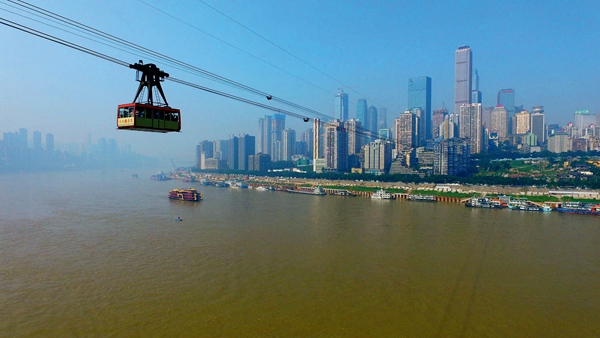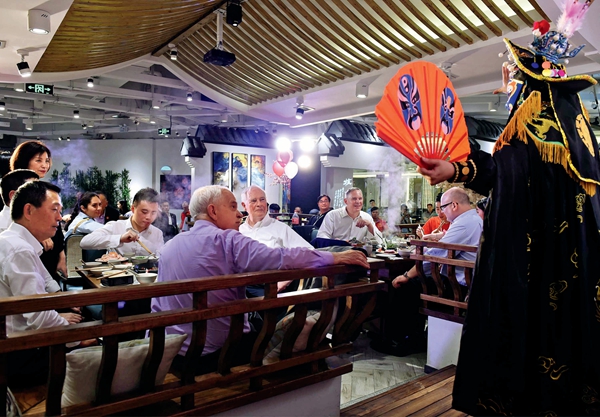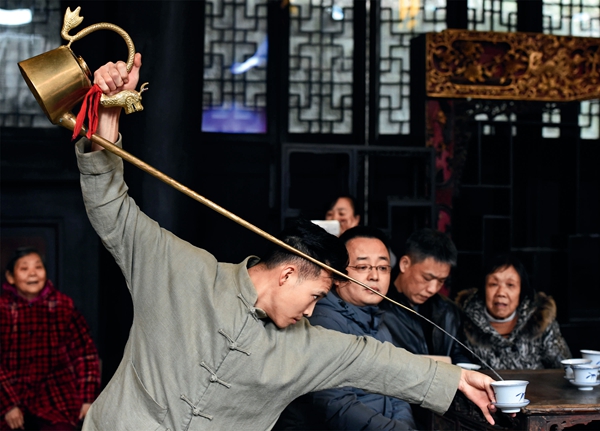Chongqing: The mountain city
 0 Comment(s)
0 Comment(s) Print
Print E-mail China Today, December 11, 2017
E-mail China Today, December 11, 2017
Chongqing, in Southwest China, is one of the four municipalities directly under the central government, the other three being Beijing, Shanghai, and Tianjin.
As the city is built on mountains, it has been nicknamed a "mountain city." The integration of mountainous terrain and urban construction creates a special landscape here. When you drive on the roads in Chongqing, you see buildings above you on one side of the road and buildings below you on the other, as well a skyline of layer upon layer of buildings on mountains. Chongqing also has another nickname, that of a "furnace," not only because of its scorching summers, but also its signature foods: spicy hotpot that enjoys a reputation nationwide as well as abroad in countries like Japan, the U.S., and Russia.

Chongqing is a center of economy, finance, shipping, culture, education, and science and technology on the upper reaches of the Yangtze River, as well as a transportation hub and collection and distribution center for goods in Southwest China. The city is also an important base for modern manufacturing.
Driving Up and Down Steep Hills
Chongqing is located at the intersection of the Yangtze and Jialing rivers. The mainstream of the Yangtze River traverses the Wushan Mountains from west to east to form the world famous Three Gorges scenic spot, the starting point of which is in Chongqing. As Chongqing is surrounded by the Daba, Wushan, and Wuling mountains, the city features a hilly landscape which is quite different from cities in plain regions. Chongqing is more "three-dimensional," with roads winding up and down and slopes dotted with houses and buildings.
Take Yuzhong District, the central district of Chongqing, as an example. Its total area is only nine square kilometers, but its sub-districts are at quite different altitudes. The elevation of Chaotianmen is 168 meters, Jiefangbei 249 meters, Pipa Hill 340 meters, and Eling Park, the highest, at about 400 meters. This has shaped Chongqing's unique urban landscape of winding roads and rolling buildings. It is interesting that locals never say that they "walk on the roads," but instead "climb the roads." The stone steps in Chongqing are considered a special aspect of the city. Locals have developed a special affection for those steep steps, on which there are people selling herbal medicines, baked sweet potatoes, needles and threads, Chinese baked sesame cakes and other varieties of breakfasts, or providing services such as ear cleaning and pedicures. Therefore, those staircases are part of local life.
Driving along the roads in Chongqing can be very thrilling, as most of them wind up and down hills. After climbing a slope, you will soon make a turn and then go down another. There is seldom a straight road whose end you can see. Driving on the flyovers in Chongqing is even more exciting. Seen from afar, the 72-meter-high Sujiaba Flyover looks like a roller coaster. The Rongqiao Flyover with three layers of roads features a spiral shape. From above, it looks like a three-storey circular motor racing track. The locals have built a 300-meter-long wave-shaped road in Banan District that directly connects to each storey of the four-floor building. Drivers experience a sense of flight while driving through the crests and troughs of this "wave" road.
The Chongqing light rail also offers tourists an exciting ride, as some sections of the track stretch across the Yangtze River, through buildings, and even through mountainside forests in order to conform to the city's complex terrain. It runs in an "S" shape in some sections and includes a 90-degree bend. It is said that no light rail in other cities can compare with that in Chongqing. Some say Chongqing brings visitors a magical experience. If you come to Chongqing, try the light rail on Line 2. It's like riding a roller coaster.
Wartime Capital of China
Due to historical reasons, Chongqing served as the administrative seat for the Republic of China's government during the period of the Chinese People's War of Resistance Against Japanese Aggression, making it a political, military, economic, cultural and educational center. The Chinese Nationalist Government chose Chong-qing as a base to lead the Chinese people's fight against invasion and carry out the revolution.
In 1931, the Japanese army launched an invasion against China. After certain major Chinese cities were occupied by the Japanese, the Nationalist Government announced in November, 1937 that it would move the capital from Nanjing to Chongqing, making Chongqing a wartime capital of China. In 1940, the Nationalist Government approved Chongqing as permanent secondary capital of China.

After the Nationalist Government chose Chongqing as its wartime capital, a large group of factories, commercial, financial, cultural, and educational, as well as scientific and research institutions moved there from coastal regions and the middle and lower reaches of the Yangtze River. Many industrial and commercial enterprises, as well as educational, scientific, cultural, and health institutions were newly established to meet the demands of war. Chongqing became a political, military, economic, and information hub of hinterland regions. World famous news agencies and newspapers such as TASS, Reuters, The Associated Press, United Press International, The Times, and The New York Times, as well as dozens of anti-fascist and anti-war institutions and organizations all opened branches in Chongqing, making the city an international platform for various countries to work together during the war.
After the Pacific War broke out, the supreme command department of allied powers in the China Theater was established in Chongqing, which was responsible for commanding allied forces from China, Vietnam, Myanmar, and Malaysia. During that time, over 30 countries, including the Soviet Union, the U.S., the U.K., and France set up embassies in Chongqing. Over 40 countries and regions established foreign affairs agencies in Chongqing. Some international anti-fascism organizations and those promoting cultural exchanges were also established in Chongqing. The city was consequently internationally influential at that time.
Today's Chongqing is one of the biggest commercial and industrial cities in Southwest China. The Chongqing-Xinjiang-Europe railway traverses about 11,179 kilometers across Kazakhstan, Russia, Belarus, and Poland before arriving in Duisburg, Germany. Since 2011, when the line came into use, more than 1,000 trains have ridden the Chongqing-Europe rail link. The rail service has facilitated exchanges between West China and Europe, with a goods delivery time 20 days quicker than by ship. Over the past few years, Chongqing's laptop output is responsible for about one third of the world's total amount, earning a reputation as "the world's largest laptop production base."
Distinctive Bayu Culture
As Chongqing is the birthplace of the ancient Ba people, and the city is known as "Yu" for short, the local culture is known as the Bayu culture, one of the most distinctive along the upper reaches of the Yangtze River. It originated in the culture of the Ba People (an ethnic group living in eastern Sichuan and some other nearby provinces in ancient China). The key elements of the Bayu culture include Sichuanese opera, Sichuan cuisine, "dock culture," the songs of Chuanjiang Haozi, which are the songs boatmen used to unify their rowing rhythm, Si-chuan embroidery, and the local Chongqing dialect.
Sichuanese Opera is popular in southwest regions such as Sichuan, Chongqing, Yunnan, and Guizhou. The face mask is an important element in these performances. As the storyline develops, performers rapidly change masks to match the mood of the character. This is a distinctive feature of Sichuanese Opera. Sichuanese Opera, which is popular throughout the country and has been promoted around the world.

Chongqing has traditionally been a transportation hub along the upstream of the Yangtze River. Docks line the river, with merchant ships shuttling back and forth. Daily communications in the dock area have promoted the exchange of cultures between the southwest region and the whole Yangtze River basin. This mix, including the civic culture of Chongqing, has formed the "dock culture," which today mainly refers to art forms relating to the local dialect and teahouse culture. Teahouses are everywhere in Chongqing. People drink tea to quench their thirst and feel refreshed. They also enjoy telling stories and chatting over cups of tea, so maintaining a good foundation for oral folk literature.
The Chongqing cuisine belongs to the Sichuan cuisine and boasts a variety of flavors and different seasonings, such as chili, Sichuan pepper, and thick broad-bean sauce. The most famous dish of this region is Chongqing hotpot. Different from a traditional Chinese dinner where people circle around to enjoy cooked dishes, two to 10, or even more gather around a pot filled with a flavorful soup base. Ingredients such as chicken, fish, pork, beef, and vegetables are served raw. Diners drop the raw ingredients in a simmering pot of water and coat them in dipping sauce before munching each mouthful with relish. There are various choices for the soup base, such as spicy red oil, or a seafood soup base. Restaurants also provide choices of dipping sauces to suit different tastes.





